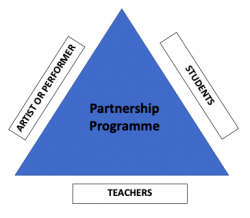BUILDING AN ARTS CULTURE – Hannah Grigg, International Community School, London
28 Jan 2022
Establishing Positive and Productive Partnership Programmes between Schools and the Arts Industry
Case Study – Hannah Grigg – Primary Music Teacher

1. THE ARTS ORGANISATION
There is an increasing demand for independent arts organisations to become a resource and connect with their community through outreach. This builds awareness of the company, creates a future regular, healthy and informed audience, and enhances the ethical identity of arts institutions and their position in society and culture. Learning departments are now commonly found in most arts and cultural institutions.
2. ARTS CURRICULUM POLICY FOR SCHOOLS
Arts organisations and teachers often struggle to justify the importance of arts education in schools. Popular opinion holds that core subjects in a school require the most attention (resources, lesson times and teacher training), yet a robust arts education enhances a child’s academic, social and emotional development. Unfortunately, in many schools the arts are a neglected part of the curriculum or school culture. In response to the lack of resources or commitment given to arts education, independent arts organisations, community ensembles and higher education institutions have teamed up with teachers to provide students with enrichment activities in the arts. For schools with a strong commitment to arts education, a partnership with an arts organisation can build on this strength.
3. PROFESSIONAL CONFIDENCE IN ARTS PEDAGOGY
A lack of attention to the arts in curriculum policy making or through school teaching and learning decisions can result in a cyclical effect of poor engagement with the arts. Students leave school with lower levels of arts education, graduate from higher education (in arts subjects and generalist teaching) with lower levels of arts competency, and then may re-enter the classroom as teachers feeling underprepared and unsupported to teach arts subjects. Similarly, many students will fail to engage in the arts as an adult if they do not receive a breadth of experience and firm understanding of the arts from school. For this reason higher education institutions, arts companies and community ensembles, have created partnerships and professional development opportunities to support arts educational experiences for teachers and students alike. This not only creates a stronger arts culture within a school, but within the community more broadly.
PARTNERSHIP PROJECTS | DESIGN
Partnership projects are conducted in a number of different ways:
- a visiting artist/performer leading workshops in a school for a designated period of time;
- an organisation supporting a school with resources, and teachers with professional learning opportunities;
- an organisation hosting a major performance event in their home (concert hall or gallery);
- higher education institutions leading workshops for schools or combining university and school ensembles for performances to provide a ‘taster’ of higher education in the arts;
- a school ensemble combining with a community ensemble to present a partnered concert; or,
- a professional organisation and an animateur presenting a performance tailored for school-aged groups, often alongside complementary workshops or resources (such as the concert Years 5 and 6 attended last term hosted by the London Philharmonic Orchestra at Royal Festival Hall).
CONSIDERING CONTEXT | PARTNERSHIP CASE STUDY AT ICS LONDON, PRIMARY
As partnership projects become more common, the nature and design of these experiences are undergoing review. The evidence suggests that partnerships are most productive and positive when the expertise of pedagogy from teachers in the school environment is combined with industry experience from working artists and performers into an experiential event. All parties within the partnership triad must give and receive equally.
A Triad Partnership Model
At ICS London, we are working in partnership with ArtsEd International to provide an extended arts offering beyond the classroom. Most recently in the Primary School, we adopted a model where a visiting performer and our talented classroom teachers together and independently taught students in preparation for an arts performance experience held at ICS London: the Winter Wonderland. Through this model, the visiting arts performer and teachers worked together and learned from one another, while ICS London students benefited from the combined experiences, practices and ideas of the two specialists in partnership. Year groups were encouraged to offer and incorporate their artistic ideas into the development and rehearsal process. In the case of the Winter Wonderland, a four-sided model was chosen, where the fourth element was the fabulous support from the ICS London parents, who gave both ideas and time to the project and (hopefully) received inspiration from participating in the performance experience.
A Four-sided Partnership Model
As teachers at an international school, it is important we focus our attention on preparing our students to enter the global world – striding with knowledge, confidence and skills in both discipline specific and cross-disciplinary areas. Through arts partnerships, we can demonstrate the integration of the arts in all facets of life, as well as promote cultural understanding and practice. By creating a rich and vibrant arts culture within the ICS London community, our students will be better equipped to engage with the world through arts and cultural understanding.
International Community School, London W2